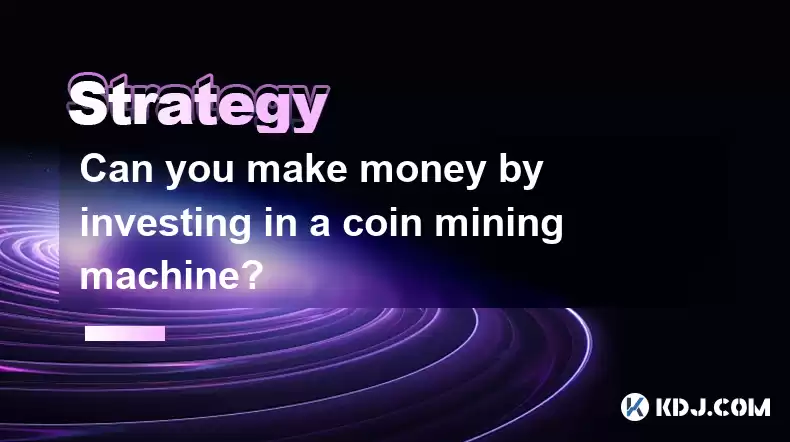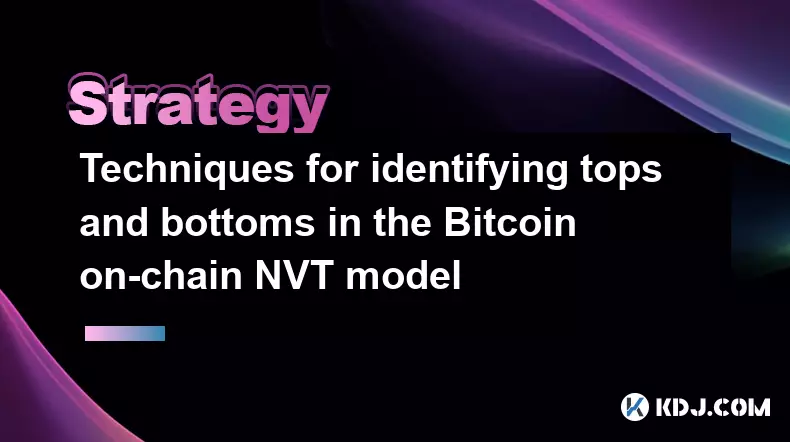-
 bitcoin
bitcoin $108842.957301 USD
-1.88% -
 ethereum
ethereum $3931.777121 USD
-1.66% -
 tether
tether $1.000186 USD
-0.03% -
 bnb
bnb $1153.250882 USD
-2.20% -
 xrp
xrp $2.367904 USD
-1.94% -
 solana
solana $186.182050 USD
-4.20% -
 usd-coin
usd-coin $0.999997 USD
0.00% -
 tron
tron $0.316949 USD
-1.00% -
 dogecoin
dogecoin $0.190780 USD
-3.12% -
 cardano
cardano $0.651324 USD
-2.67% -
 hyperliquid
hyperliquid $37.141055 USD
-0.85% -
 ethena-usde
ethena-usde $0.999224 USD
-0.09% -
 chainlink
chainlink $17.579031 USD
-2.47% -
 bitcoin-cash
bitcoin-cash $509.426284 USD
-2.79% -
 stellar
stellar $0.315298 USD
-2.93%
Can you make money by investing in a coin mining machine?
Mining profitability depends on various factors, such as electricity costs, hardware efficiency, and network difficulty, making it crucial to carefully consider potential risks and rewards before investing in a coin mining machine.
Jan 09, 2025 at 08:11 am

- Mining machines require significant capital investment and specialized knowledge.
- Mining profitability is volatile and depends on factors such as electricity costs, hardware efficiency, and network difficulty.
- Pool mining offers lower upfront costs but reduces individual earnings.
- Cloud mining allows remote access to mining operations but involves risks.
- Consider factors such as payback period, power consumption, and hardware obsolescence before investing.
Investing in a coin mining machine can potentially generate profits, but it is a complex and risky endeavor that requires careful consideration. Here's a comprehensive guide to help you assess the profitability and challenges involved:
1. Capital InvestmentMining machines can range from a few hundred to several thousand dollars. Miners must purchase specialized hardware, such as ASICs (Application-Specific Integrated Circuits) or GPU (Graphics Processing Units), which are specifically designed for cryptocurrency mining.
2. Electricity CostsMining operations consume significant amounts of electricity. Miners should factor in the cost of electricity and compare it to the potential earnings from the mined coins. High electricity costs can erode profitability.
3. Mining DifficultyThe difficulty of mining a particular cryptocurrency is dynamically adjusted based on the number of miners participating in the network. As the difficulty increases, it requires more computational power and energy to mine a coin.
4. Hardware EfficiencyThe efficiency of the mining hardware determines the amount of electricity required to generate a hash. More efficient hardware consumes less electricity, reducing operating costs.
5. Pool MiningPool mining involves joining a group of miners who combine their computational resources to increase their chances of finding a block and earning a reward. Pool mining reduces the upfront investment cost but also divides the earnings among the members.
6. Cloud MiningCloud mining allows investors to rent computational power from remote mining operations. This eliminates the need for physical hardware and reduces the risks associated with purchasing and maintaining equipment. However, cloud mining fees may reduce profitability.
7. Payback PeriodThe payback period refers to the time it takes for the machine to generate enough revenue to cover its initial cost. Miners should consider the potential profitability of the machine and electricity costs to estimate the payback period.
8. Power Consumption and NoiseMining machines can generate substantial heat and noise. Proper cooling and ventilation systems may be necessary to prevent damage to the equipment and ensure a comfortable working environment.
9. Hardware ObsolescenceMining hardware technology is rapidly evolving. Miners should consider the potential for their equipment to become obsolete and its resale value.
FAQs:Q: Is it still profitable to mine cryptocurrency?A: Mining profitability depends on various factors, including cryptocurrency prices, network difficulty, and operating costs. It is important to conduct thorough research and consider the potential risks and rewards before investing.
Q: What is the best cryptocurrency to mine?A: The best cryptocurrency to mine varies based on market conditions and profitability. Factors to consider include coin price, network difficulty, and energy consumption.
Q: How can I avoid mining scams?A: Be wary of companies that promise unrealistic profits or guarantee returns. Conduct thorough research, read reviews, and only invest in reputable mining operations.
Disclaimer:info@kdj.com
The information provided is not trading advice. kdj.com does not assume any responsibility for any investments made based on the information provided in this article. Cryptocurrencies are highly volatile and it is highly recommended that you invest with caution after thorough research!
If you believe that the content used on this website infringes your copyright, please contact us immediately (info@kdj.com) and we will delete it promptly.
- Navigating Crypto Chaos: Is Bitcoin, Ethereum, or Solana a Safe Haven?
- 2025-10-18 02:25:13
- Altcoin Season on Hold? Index Tumbles Amidst Data Analysis
- 2025-10-18 02:45:12
- Boston Music Awards 2025: Nominees Announced!
- 2025-10-18 02:45:12
- Morpho's DeFi Dance: Liquidity Slides, Ethereum Foundation's Moves, and What It All Means
- 2025-10-18 02:50:13
- OpenSea's Multi-Chain Evolution: From NFTs to Crypto Aggregator
- 2025-10-18 02:25:13
- SEA Token, OpenSea, and Trading Volume: What's the Deal?
- 2025-10-18 02:26:10
Related knowledge

Practical parameter settings for a Bitcoin multi-timeframe moving average system
Sep 18,2025 at 10:54pm
Optimizing Timeframe Combinations for Bitcoin Trading1. Selecting appropriate timeframes is crucial when building a multi-timeframe moving average sys...

How can I filter out false breakouts in Dogecoin high-frequency trading?
Sep 22,2025 at 01:00am
Understanding False Breakouts in Dogecoin Trading1. A false breakout occurs when Dogecoin's price appears to move beyond a defined support or resistan...

Techniques for identifying tops and bottoms in the Bitcoin on-chain NVT model
Sep 20,2025 at 07:54pm
Understanding the NVT Model in Bitcoin Analysis1. The Network Value to Transactions (NVT) ratio is often described as the 'P/E ratio' of the cryptocur...

What does the surge in open interest in Bitcoincoin futures mean?
Sep 20,2025 at 11:18pm
Understanding the Surge in Dogecoin Futures Open Interest1. A surge in open interest within Dogecoin futures indicates a growing number of active cont...

How can I use the Ethereum USDT premium to gauge market sentiment?
Sep 18,2025 at 11:55pm
Understanding the Ethereum USDT Premium1. The Ethereum USDT premium refers to the price difference between USDT (Tether) traded on Ethereum-based plat...

What should I do if Ethereum staking yields decline?
Sep 20,2025 at 06:18am
Understanding the Causes Behind Declining Ethereum Staking Yields1. The Ethereum network transitioned to a proof-of-stake consensus mechanism with the...

Practical parameter settings for a Bitcoin multi-timeframe moving average system
Sep 18,2025 at 10:54pm
Optimizing Timeframe Combinations for Bitcoin Trading1. Selecting appropriate timeframes is crucial when building a multi-timeframe moving average sys...

How can I filter out false breakouts in Dogecoin high-frequency trading?
Sep 22,2025 at 01:00am
Understanding False Breakouts in Dogecoin Trading1. A false breakout occurs when Dogecoin's price appears to move beyond a defined support or resistan...

Techniques for identifying tops and bottoms in the Bitcoin on-chain NVT model
Sep 20,2025 at 07:54pm
Understanding the NVT Model in Bitcoin Analysis1. The Network Value to Transactions (NVT) ratio is often described as the 'P/E ratio' of the cryptocur...

What does the surge in open interest in Bitcoincoin futures mean?
Sep 20,2025 at 11:18pm
Understanding the Surge in Dogecoin Futures Open Interest1. A surge in open interest within Dogecoin futures indicates a growing number of active cont...

How can I use the Ethereum USDT premium to gauge market sentiment?
Sep 18,2025 at 11:55pm
Understanding the Ethereum USDT Premium1. The Ethereum USDT premium refers to the price difference between USDT (Tether) traded on Ethereum-based plat...

What should I do if Ethereum staking yields decline?
Sep 20,2025 at 06:18am
Understanding the Causes Behind Declining Ethereum Staking Yields1. The Ethereum network transitioned to a proof-of-stake consensus mechanism with the...
See all articles










































































